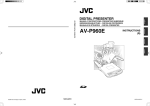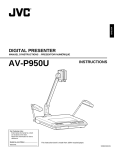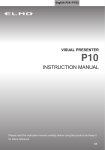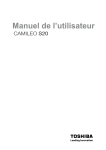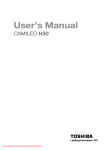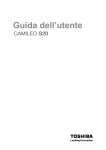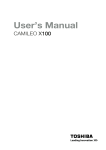Download JVC AV-P960E Projector User Manual
Transcript
AV-P960E INSTRUCTIONS (A) Français MANUEL D’INSTRUCTIONS: PRESENTOIR NUMERIQUE BEDIENUNGSANLEITUNG : DIGITALEN VORFÜHRERS MANUALE DI ISTRUZIONI : DIGITAL PRESENTER Italiano Deutsch AV-P960E DIGITAL PRESENTER English DIGITAL PRESENTER ® ® is a registered trademark owned by Victor Company of Japan, Ltd. is a registered trademark in Japan, the U.S.A., the U.K. and many other countries. © 2004 Victor Company of Japan, Ltd ® Printed in Thailand LWT0149-001B-H LWT0149-001B-H Safety Precautions For Europe 䡵 Dimensioni (LHP) (apparecchio: mm) IMPORTANT WARNING: The wires in this mains lead are coloured in accordance with the following code: GREEN - and - YELLOW: EARTH BLUE: NEUTRAL BROWN: LIVE As the colours of the wires in the mains lead of this apparatus may not correspond with the coloured markings identifying the terminals in your plug, proceed as follows. The wire which is coloured GREEN-AND-YELLOW must be connected to the terminal in the plug which is marked with the letter E or the safety earth symbol or coloured GREEN or GREEN-AND-YELLOW. The wire which is coloured BLUE must be connected to the terminal which is marked with the letter N or which is coloured BLACK. The wire which is coloured BROWN must be connected to the terminal which is marked with the letter L or coloured RED. TO PREVENT FIRE OR SHOCK HAZARDS, DO NOT EXPOSE THIS APPLIANCE TO RAIN OR MOISTURE. Warning Machine noise information regulation 3. GSGV, 18.01.1991: The highest sound pressure level amounts to 70 railway (A) less or in accordance with ISO/EN 7779 378 This is a Class A product. In a domestic environment this product may cause radio interference in which case the user may be required to take adequate measures. 495 (chiuso) Thank you for purchasing this JVC product. Before operating this unit, please read these instructions carefully to ensure the best possible performance. These instructions are for AV-P960E. Smooth, High Resolution Images Built-in SD Card Slot XGA output with high frame rate of 20 fps enabling smooth high resolution image display. Built-in high capacity, high speed SD card compatible memory slot. (SD Card is sold separately.) High Definition and High Power Zoom Versatile Interface Built-in 12x Optical Zoom Lens and 4x Digital Zoom. Equipped with USB and RS-232 connector. 190 (chiuso) Features Italiano 653 (aperto formato A3) WARNING–THIS APPARATUS MUST BE EARTHED 491 (aperto) I dati tecnici e il design di questo apparecchio sono soggetti a modifiche e miglioramenti senza preavviso. Small, Lightweight and Slim Design Depth of less than 50 cm and lightweight at below 6 kg, yet equipped with a field angle equivalent to A3 landscape (376 mm x 282 mm). E-2 I-27 Table of Content Safety Precautions .................................................................... 2 Features ..................................................................................... 2 Getting Started Precautions ................................................................................ 4 Names and Functions ............................................................... 5 Overall View ....................................................................................... 5 Control Panel ..................................................................................... 6 Rear Panel .......................................................................................... 8 Preparation Before Using .............................................................................. 9 Connection .............................................................................. 10 Presenting Printed Materials .................................................. 11 Presenting 3-dimensional Objects ........................................ 12 Shooting Surrounding Objects .............................................. 13 Operation (Basic) Presenting Slide Films ............................................................ 14 Presenting Films and Other Transparent Materials ............. 15 Capturing Images Through a Microscope ............................. 16 Saving Images in the Picture Memory .................................. 17 Adjusting the White Balance .................................................. 18 Saving the Settings (User Setting Registration) .................. 19 Operation (Application) Storing Images in SD Card ..................................................... 20 Viewing Image Data Stored in SD Card ................................. 21 Connecting to Computer via the USB Connector ................ 22 Operating the Remote Control Unit ....................................... 23 Others Installing LCD Monitor ............................................................ 24 Troubleshooting ...................................................................... 25 Specifications .......................................................................... 26 How to Read this Manual 䡵 Symbols used in this manual Caution Note ☞ States precautions to be taken during operations. States restrictions on the functions or use of this equipment. For reference purposes. Indicates the page numbers or items to refer to. 䡵 Contents of this manual ● The copyright of this manual belongs to JVC. Unauthorized reproduction of this manual whether in full or in part is prohibited. ● All product names stated in this manual are trademarks or registered trademarks of their respective companies. Marks such as ™, ® and © are omitted in this manual. ● The design, specifications and other contents of this manual are subject to change for improvements without prior notice. ● Windows is the trademark of Microsoft Corporation in the United States. : SD logo is a trademark. ● E-3 English Table of Content ........................................................................ 3 Precautions 䡵 Handling of Equipment ● Use the handle on the side to carry this unit. Carrying this unit by its camera head, camera arm or its side illumination lamps might cause them to be deformed or damaged. ● Pull out the handle slowly in a straight manner. 䡵 Conduct prior functional checks before important shooting events. 䡵 Compensation for the shooting contents ● JVC will not be in anyway liable for any failure to take or playback images due to problems arising from this product or the card used, and no compensation will be offered for the loss of contents. 䡵 Copyright ● You may take pictures for your own leisure or uses. However, you must not use any materials protected by copyright law without the owner's consent. 䡵 SD Card SD card is made from precision electronic components. Do not attempt to carry out any of the following actions as it may cause the card to malfunction or damage. ● Do not touch the edge of the card with your bare hand or metal. It may be damaged by static charges produced. ● Do not bend, drop or cause the card to suffer great impacts. ● When using and storing the card, avoid heat, water, direct sunlight and humid areas. ● Do not attempt to disassemble or modify the card. 䡵 Routine maintenance Switch off the power, pull out the plug and perform the following tasks. ● Use a dry and soft piece of cloth to wipe off any dirt or stain on the equipment. ● For severe stains, immerse a piece of cloth into a diluted cleaning detergent, wring and use it to wipe off the stains on the equipment. Thereafter, use a piece of dry cloth to wipe off the water drops. Caution ● Do not use benzene or thinner. The equipment may malfunction and its casing may be damaged. ● When using a chemical wrap or detergent, read its product brochures carefully and take note of any precautions stated. 䡵 Auto Focus This unit is equipped with Auto Focus function. However, depending on the object and the camera setting, it might be out of focus. In this case, please adjust the focus manually. Objects which are difficult to be focused automatically ● ● ● ● ● ● When the brightness of the image plane is extremely high (bright). When the brightness of the image plane is extremely low (dim). When the brightness of the image plane is constantly changing (for example, a blinking light). When there is almost no contrasts. When there are repetitive vertical striped patterns on the image plane. When there are graphics or printings on both sides or the upper and lower portions of the screen. 䡵 Power Cord ● Use only the power cord specified (supplied). Use of power cord other than designated, or damaged power cord may result in fire and electrical shocks. ● Do not use the power cord supplied with this unit on other devices. 䡵 Power Saving To save power, turn off the unit when not in use. E-4 Names and Functions Overall View English 1 0 ! 2 Rear Panel ☞ Page 7 3 4 4 Right Side @ 5 6 7 Control Panel ☞ Page 6 8 1 Camera Head For capturing images of objects on the stage or surrounding areas. 2 Camera Arm Supporting arm for the camera head. Adjust its angle when shooting 3-dimensional objects. 3 Arm Lock For adjusting the length of camera. Release the lock when retracting or extending the camera arm and lock it at the adjusted position. 4 Side Illuminations Adjust to ensure that the stage is evenly lighted. 5 Handle Pull out this handle to carry the unit. Put the handle away when not in use. 6 Back Illumination Use this lighting when viewing transparent materials such as films. ☞ Page 15 ‘Presenting Films and Other Transparent Materials’ 9 7 Stage For placing objects (or materials). Up to A3 landscape equivalent (376 mm x 282 mm) can be captured. 8 Remote Sensor For receiving signals from the remote control unit. ☞ Page 23 ‘Operating the Remote Control Unit’ 9 SD Slot Slot for inserting the SD card. ☞ Page 20 ‘Storing Images in SD Card’ 0 Slide Film Holder Use this when viewing slide films. ☞ Page 14 ‘Presenting Slide Films’ ! Close-up Lens Remove this lens when shooting surrounding objects. ☞ Page 13 ‘Shooting Surrounding Objects’ @ Power Switch To turn on/off the power. E-5 Names and Functions (continued) Control Panel # @ ! 0 9 8 7 6 5 4 3 2 1 USER SETUP DEFAULT USER SAVE DELETE WHITE BALANCE AUTO CAMERA RED PICTURE MEMORY 1 2 3 PAGE NEGA POSI BW COLOUR SAVE LIGHT TEXT IMAGE SELECT ENTER SD CARD % ^ & BRIGHT CAMERA AUTO FOCUS ZOOM EXT IN OUT IN SOURCE SELECT * 1 [ZOOM] Adjustment Buttons Adjust in accordance with the object. [IN] : To shoot objects (materials) in an enlarged form. If this button is pressed continuously, the image will stop enlarging at the optical zoom tele end and thereafter digital zoom will be activated. (Optical zoom: 12x, Digital zoom: 4x) [OUT] : To shoot objects (materials) in a reduced form. 2 [BRIGHT] Adjustment Buttons For adjusting the brightness of the camera image. [AUTO] : When this button is pressed, the indicator lamp will blink and the brightness will be adjusted automatically. The indicator lamp will go off once the adjustment is completed. [ ] : To increase the brightness of the camera image. [ ] : To reduce the brightness of the camera image. 3 [FOCUS] Adjustment Buttons For adjusting the focus of the camera. [ ] : To adjust the focus of the object (material) which is far away from the camera. [ ] : To adjust the focus of the object (material) which is close to the camera. [AUTO] : When this button is pressed, the indicator lamp will blink and the focus will be adjusted automatically. The indicator lamp will go off once the adjustment is completed. Depending on the object (material), it may be difficult to adjust the focus. ☞ Page 4 ‘Auto Focus’ E-6 AUTO MICROSCOPE SD CARD SYSTEM $ FREEZE BLUE 4 [FREEZE] Button When this button is pressed, the camera image freezes and is displayed as a still image, and the indicator lamp lights up. When the button is pressed again while the indicator lamp is light up, the indicator lamp will go off, still image will be released and the moving image will be restored. 5 [SOURCE SELECT] Buttons for Selecting Output Image To select the image to be outputted from the [RGB OUTPUT] terminal and the [MONITOR OUTPUT] terminal located at the rear panel. The indicator lamp of the input source selected for outputting will light up. Depending on the types of monitor connected , it may take some times for the images to be displayed. [CAMERA] : To output the camera images. [EXT IN] : To output signals inputted to the [EXT INT] terminal located at the rear panel. External input signals will not be output through the [MONITOR OUTPUT] terminal. [SD CARD] : To output images from the SD card inserted in the slot. ☞ Page 21 ‘Viewing Image Data Stored in SD Card’ 6 [LIGHT] Button for Switching Lighting To switch between different lighting sources. The lighting source changes whenever the button is pressed. Side illuminations Back illumination All illuminations off 7 ~ 0 are functional only if SD card is inserted into the SD Slot. 7 [IMAGE SELECT/ENTER] Button for Selecting Images Displays the miniature images of the SD card in a view of 16. ☞ Page 21 ‘Viewing Image Data Stored in SD Card’ 8 [SAVE] Button for Saving SD Card While selecting images from the camera, if this button is pressed for more than 2 seconds, the indicator lamp will blink and the image currently displayed will be stored in the SD card. ☞ Page 20 ‘Storing Images in SD Card’ 9 [PAGE] Buttons To select and display images stored in the SD card. [ ] : To view the previous image. [ ] : To view the next image. 0 [DELETE] Button for Deleting SD Card To delete selected images stored in the SD card. When the [SD CARD] has been selected by the [SOURCE SELECT] button 5, pressing this button for more than 2 seconds, the indicator lamp will blink and the selected image will be deleted. ☞ Page 20 ‘Deleting images’ ! [PICTURE MEMORY] Buttons To store the output image in the internal picture memory or to select and display the images stored in the picture memory. [1] ~ [3] : Press the button for more than 2 seconds, the button indicator lamp # will blink and the image will be stored in the picture memory. Press this button to output the stored image. [CAMERA] : To select the camera image. ☞ Page 17 ‘Saving Images in the Picture Memory’ @ [USER SETUP] Buttons for Setting Registration To perform settings related to value setting. [SAVE] : The present user settings will be registered. [USER] : The registered settings will be activated. [DEFAULT] : Setting reverts back to default (factory) setting. ☞ Page 19 ‘Saving the settings (User Setting Registration)’ # Button Indicator Lamps Indicator lamps will blink when button ! ~ * has been operated and the various settings are in the process of being changed. $ [WHITE BALANCE] Adjustment Buttons To perform settings related to white balance. [AUTO] : If this button is pressed, the indicator lamp will blink while the white balance is being readjusted. [RED ] : Increase the red component of the entire screen. [RED ] : Decrease the red component of the entire screen. [BLUE ] : Increase the blue component of the entire screen. [BLUE ] : Decrease the blue component of the entire screen. ☞ Page 18 ‘Adjusting White Balance’ % [NEGA/POSI] Button for Switching between Negative/Positive Film Set to Nega when viewing negative films. Negative will be selected when the button is pressed. Press the button again, positive will be selected. ☞ Page 15 ‘Presenting Films and Other Transparent Materials’ ^ [BW/COLOUR] Button for Switching between Black & White and Colour To switch the output image between Black & White and Colour display. Black & White image will be selected when the button is pressed. Press the button again, Colour image will be selected. & [TEXT] Button To make the character clearer and sharper. Text mode will be activated when the button is pressed. To deactivate, press the button again. * [MICROSCOPE] Button Press this button when capturing images from a microscope. Once the button is pressed, the zoom and focus meant for microscope will be set. ☞ Page 16 ‘Capturing Images Through a Microscope’ E-7 English SD CARD SYSTEM Names and Functions (continued) Rear Panel Refer to page 10 ‘Connection’ for details on connecting with other devices. Caution Do not open the cover at the bottom of the arm and put your finger or insert object into it. This may cause malfunction or injury. 1 AC IN 2 345 6 7 8 USB MONITOR OUTPUT RGB OUTPUT EXT INPUT REMOTE INPUT (RS-232C) NTSC 1 [AC IN] Power Inlet Connect using the power cord supplied to an AC 100 V ~ AC 240 V power source. 2 [MONITOR OUTPUT] Terminal Image signal output terminal for confirming viewing angle. PAL 5 [EXT INPUT] Terminal for External Signal Input For connecting to external devices such as computer. When using the [SOURCE SELECT] button to select the external input, the signals will be output through the [RGB OUTPUT] terminal. In this case, output through the [MONITOR OUTPUT] terminal is not possible. 3 [RGB OUTPUT] Terminal RGB signal output terminal. Connect to the RGB input terminal of a projector or monitor. 4 [USB] Connector For connecting to devices such as computer. Image data or image memory stored in the SD card as well as image data stored in this unit can be downloaded to the computer. ☞ Page 22 ‘Connecting to Computer via the USB Connector’ 6 LCD Monitor Mounting Screw Hole Use when mounting the LCD Monitor (sold separately) to this unit. ☞ Page 24 ‘Installing LCD Monitor’ 7 [REMOTE INPUT (RS-232C)] Terminal Connect when controlling this unit via the PC using the control software created by customer. For communication method and command, read [RS-232C External control communication commands (command. pdf)] in the provided CD-ROM. 8 [NTSC/PAL] Switch Set according to the monitor to be used. E-8 Before Using Install according to the following steps. Right Illumination Left Illumination 1. Lift up the right illumination 2. Lift up the left illumination 3. Lift up the camera head (camera arm) English 1. 2. Hold the camera arm and hold down the unit firmly while slowly lifting the camera head until it reaches its maximum position and stops. 4. Camera Head 4. Releasing the arm lock Pull the lever of the arm lock in the direction of the arrow as shown in the figure to release the lock. Camera Arm Arm Lock 3. 5. Extending the camera arm Hold down the lower portion of the camera arm or the unit firmly while holding the upper portion of the camera arm and slowly extend the camera arm until it reaches its maximum position and stops. 6. Return the lever of the arm lock in the direction of the arrow to lock the arm. 5. 7. 6. Camera Arm Securing the camera arm Arm Lock 7. Turn the camera head towards the stage Carry out the reverse steps to fold up. Stage If the steps are carried out wrongly, the camera head and arm may be damaged. Caution ● When retracting the camera arm, do not hold the connecting portion of the camera arm with your hand. It might get caught resulting in injury. Caution ● Do not try to retract or extend the camera arm when it has been folded forward. The interior of the camera arm may be damaged if excessive force is applied. Make sure that the camera head (camera arm) has been lifted up as described in Step 3. before retracting or extending the camera arm. ● Do not hold the camera head when lifting, folding, retracting or extending the camera arm. The camera head and the interior of camera arm may be damaged if excessive force is applied. Make sure to hold the camera arm when performing steps 3. and 5.. E-9 Connection Install according to the following steps. The [MONITOR OUTPUT] terminal is use to confirm the images. LCD Monitor Computer 2. [MONITOR OUT] [RGB OUT] 5. 3. [USB] Terminal Power Switch USB Terminal Projector Left Illumination [AC IN] 4. 1. (supplied power cord) AC Power The LCD monitor, computer and projector are sold separately. 1. Connect the [RGB OUTPUT] terminal to a projector or display. ● The output of this unit is XGA, connect it to a compatible device. ● Commercially available D-sub 15 pin cable (below 3 m) is recommended. 2. If necessary, connect the [MONITOR OUTPUT] terminal to a monitor etc. 3. If necessary, connect the USB connector to a computer. ☞ Page 22 ‘Connecting to Computer via the USB Connector’ E-10 4. Connect to the AC power source with the power cord supplied. 5. Turn on the power. Presenting Printed Materials Camera Head 1. Arm 1. 1. Adjusting the arm and camera head Adjust the arm and camera head in accordance with the size of the object. 2. ● Ensure that the camera head is positioned at the centre of the object. 2. ● The arm is catered to capture an A3 landscape equivalent object when fully extended. [BRIGHT] button [ZOOM] button 2. Adjusting lighting Adjust such that the object is evenly lighted. [FOCUS] button 3. Adjusting zoom Adjust such that the portion of the object to be captured occupies the full screen. ZOOM OUT (Example) Too little zooming. 4. IN Adjusting brightness AUTO BRIGHT Adjust when the screen is too bright or too dim. Press the [AUTO] button and the appropriate brightness will be adjusted automatically. (Example) Poor lighting. 5. Adjusting focus AUTO FOCUS To adjust the focus when it is out. Press the [AUTO] button and the focus will be adjusted automatically. (Example) Focus is out. Note ● For materials with a mixture of portrait and landscape printed materials, it may be more convenient to save either one of the orientations under the user setting. (☞ Page 19 ‘Saving the Settings (User Setting Registration)’) (Example) Correctly adjusted. E-11 English Up to A3 landscape equivalent (376 mm x 282 mm) printed materials can be captured. Presenting 3-dimensional Objects 3-D object placed on the stage can be captured. In addition, by adjusting the angle of the arm, the 3-D object can be captured at various angles. 1. 1. Adjusting the arm and camera head Adjust the arm and camera head in accordance with the size of the object. ● Ensure that the camera head is positioned at the centre of the object. ● The arm is catered to capture an A3 landscape equivalent object when fully extended. 2. 2. 2. Adjusting lighting Adjust such that the portion of the object to be captured is evenly lighted. 3. Adjusting zoom ZOOM OUT 4. Adjust such that the portion of the object to be captured occupies the full screen. IN Adjusting brightness AUTO BRIGHT Adjust when the screen is too bright or too dim. Press the [AUTO] button and the appropriate brightness will be adjusted automatically. 6. 5. Adjusting focus AUTO FOCUS To adjust the focus when it is out. Press the [AUTO] button and the focus will be adjusted automatically. 6. Tilt the arm at an angle to capture Note ● 3-D objects if taken from a slanting angle provides realistic images. E-12 Shooting Surrounding Objects Camera Head 1. Turn the camera head towards the object 2. Remove the close-up lens English The camera head can be turned to shoot the surrounding objects. 1. Press and hold the claws while pulling out the lens. 3. Adjusting the image Adjust the zoom, brightness and focus. 2. Close-up lens 3. [BRIGHT] button [ZOOM] button [FOCUS] button E-13 Presenting Slide Films Slide films with frame can be inserted directly into the camera head for presentation. 1. Place a piece of white paper on the stage As the slide film makes use of the reflecting light from the stage surface, place a highly reflective white paper (B4 size or A3 size) on the stage. 2. 2. 1. [BRIGHT] button 2. Adjusting side illuminations Adjust such that the stage surface is evenly lighted. te Whi er pap [ZOOM] button 3. Stage Insert the slide film Note Use only slide films with mounting frame. 4. 3. Adjusting zoom ZOOM OUT 5. Adjust such that the portion of the object to be captured occupies the full screen. IN Adjusting brightness AUTO Adjust the brightness while looking at the image displayed on the monitor. BRIGHT Notes 5. [BRIGHT] button 4. [ZOOM] button 6. [FOCUS] button ● Automatic brightness adjustment will be disabled whenever Nega is selected. The indicator lamp blinks rapidly to indicate that operation is not possible. ● Under negative mode, pressing the [BRIGHT ] button dims the images while pressing the [BRIGHT ] button brightens the images. ● Under negative mode, pressing the [WHITE BALANCE] buttons [RED ] or [BLUE ] decreases the red or blue component while pressing the [RED ] or [BLUE ] button increases the red or blue component. 6. Adjust focus Use the [FOCUS , ] buttons to adjust the focus. Note If the slide film is inserted vertically, zooming in (enlarging) until the mounting frame cannot be seen may cause the focus to be out. In this case, set zoom to [OUT]. E-14 Presenting Films and Other Transparent Materials Films can be placed on the stage for presentation. Press the [LIGHT] button to turn on the back illumination English 1. The lighting source changes whenever the [LIGHT] button is pressed. Side illuminations Back illumination 2. Back illumination All illuminations off Place the films and other transparent materials on the stage Place the film at the centre of the stage and adjust the camera head directly on top of the film. 1. [LIGHT] button 3. Setting Nega/Posi In the case of a negative film, press the [NEGA/POSI] button to set to negative mode. 4. Adjusting zoom ZOOM OUT 5. 5. 3. IN Adjusting brightness AUTO 6. 4. Adjust such that the portion of the object to be captured occupies the full screen. Adjust the brightness while looking at the image displayed on the monitor. BRIGHT Notes ● Automatic brightness adjustment will be disabled whenever Nega is selected. The indicator lamp blinks rapidly to indicate that operation is not possible. ● Under negative mode, pressing the [BRIGHT ] button dims the images while pressing the [BRIGHT ] button brightens the images. ● Under negative mode, pressing the [WHITE BALANCE] buttons [RED ] or [BLUE ] decreases the red or blue component while pressing the [RED ] or [BLUE ] button increases the red or blue component. 6. Adjust focus Use the [FOCUS , ] buttons to adjust the focus. E-15 Capturing Images Through a Microscope Images from the microscope can be captured by aligning the view piece of the microscope with the camera head. The procedures described below are for using the adaptable microscope ECLIPSE E200 from Nikon. 4. 1. 3. Setting the microscope ● Prepare the microscope, such as focus adjustment, for viewing. ● For the usage of the microscope, refer to the instruction manual of the microscope. 2. Place the microscope on a platform of about 10 cm high 3. Remove the close-up lens 4. Adjust the position of the camera head 2. USER SETUP DEFAULT USER SAVE WHITE BALANCE AUTO CAMERA RED BLUE PICTURE MEMORY 1 2 NEGA POSI BW COLOUR TEXT 3 Adjust the camera head and the view piece of the microscope such that their respective centre are aligned. ● Adjust the length and angle of the arm. ● Adjust the angle of camera head. MICROSCOPE 5. 5. Press the [MICROSCOPE] button 6. Adjusting the image ● Adjust the brightness and focus while confirming the images. E-16 Saving Images in the Picture Memory Frequently used images can be saved in the picture memory of this unit. Switching between camera images and images from the picture memory is possible while presentation is in progress. Up to 3 images can be saved. Press the [CAMERA] button English 1. The camera image is outputted. [BRIGHT] button Button Indicator Lamp [ZOOM] [FOCUS] button button 2. Adjusting zoom 3. Adjusting brightness 4. Adjusting focus 5. Press [PICTURE MEMORY 1] button for more than 2 seconds USER SETUP DEFAULT USER SAVE ● The button indicator lamp will light up initially before blinking. It will go off once the image has been saved. ● The image will become still image. WHITE BALANCE AUTO CAMERA RED BLUE PICTURE MEMORY 1 2 NEGA POSI BW COLOUR TEXT 3 6. MICROSCOPE Repeat Steps 1. ~ 5. Perform the same procedures for picture memory 2 and 3. 1. 5. 䡵 Retrieving Stored Images 1. Press the [PICTURE MEMORY] button The stored images in this unit will be displayed. Note ● When retrieving the images stored in this unit, do not press the [PICTURE MEMORY] buttons for more than 2 seconds. The image will be stored. ● If no image is stored in the picture memory, the screen will turn black and nothing will be displayed when the [PICTURE MEMORY] button is pressed. Notes ● This unit is designed to display A4 portrait in full with the camera arm fully extended. For materials with a mixture of portrait and landscape pages, it may be convenient to save either one of the orientations in the picture memory before presenting. ● Contents of the picture memory are lost if the power is turned off. ● Existing images stored in the picture memory will be overwrite whenever new images are being stored. ● SD images cannot be stored in this unit. E-17 Adjusting the White Balance 䡵 Adjusting the White Balance Automatically This unit is adjusted to display the natural colour. However, the white balance can be re-adjusted with the following steps. 1. Place a piece of white paper on the stage 2. Adjusting zoom Adjust till the full screen becomes white. White paper 3. Adjusting brightness 4. Press the [WHITE BALANCE AUTO] button The white balance will be re-adjusted in about 5 seconds. ● The button indicator lamp will blink initially, and goes off once the white balance adjustment has been completed. [WHITE BALANCE AUTO] button 䡵 Adjusting the White Balance Manually Depending on the object, if the images appear reddish, bluish or the overall colour tone appears to be bad even after the automatic white balance adjustment has been performed, adjust the colour balance manually. RED Increase the red component Decrease the red component BLUE Increase the blue component Decrease the blue component USER SETUP DEFAULT USER SAVE WHITE BALANCE AUTO CAMERA RED PICTURE MEMORY 1 2 NEGA POSI BW COLOUR E-18 BLUE TEXT 3 MICROSCOPE Saving the Settings (User Setting Registration) 䡵 Registration 1. Adjusting the camera ● Adjust the camera to the settings to be registered. ● The following user settings are possible. ( ) are factory settings. • Zoom position (Approximately A4 portrait position) • Lighting status (Both side illuminations light up) • White Balance (Value corresponding to side illumination) • Nega/Posi (Posi) • Black & White/Colour (Colour) • Text (OFF) 2. Button Indicator Lamp ● The button indicator lamp will light up initially before blinking. It will go off once the writing process has been completed. ● The written settings will be retained even if the power is turned off. USER SETUP DEFAULT USER SAVE WHITE BALANCE AUTO CAMERA RED BLUE PICTURE MEMORY 1 2 NEGA POSI BW COLOUR Press the [SAVE] button for more than 2 seconds TEXT 3 MICROSCOPE 䡵 Recalling the settings 1. Press the [USER] button ● The registered settings will be activated. 䡵 Undo the settings (Restoring the factory settings) 1. Press the [DEFAULT] button ● The factory settings will be restored. 2. Press the [SAVE] button for more than 2 seconds ● The button indicator lamp will light up initially before blinking. It will go off once the writing process has been completed. E-19 English The recalled settings upon power up or when the [USER] button is pressed can be registered. Storing Images in SD Card Images taken can be stored in the SD card (sold separately). 1. Press the [CAMERA] button 2. Insert the SD card ● To remove the SD card, push in the card before removing it from the card slot. 1. 3. ● The save indicator lamp lights up ➞ Blinks while saving is in progress. Blinks ➞ Lights up ➞ Light goes off once saving is completed. (about 2 seconds) ● Saving is not possible if the SD card switch has been turned on to write-protect. In this case, the save indicator lamp will not blink. ● If the SD card is full and additional images cannot be stored, the save indicator lamp will not blink. In this case, delete unwanted images or use a new card. 2. DELETE SAVE 3. PAGE Press the [SAVE] button for more than 2 seconds IMAGE SELECT ENTER SD CARD SYSTEM 䡵 Deleting images 1. Select the image to delete ● <Normal screen> To delete image, use the [PAGE image to be deleted. , ] buttons to select the ● <Thumbnail screen> When the thumbnail screen is being displayed, use the [PAGE , ] buttons to move the cursor to select the image to be deleted. Notes ● If an image is deleted in the thumbnail screen, the next image will shift up and be displayed in its position. ● The cursor will move to the next image following the deleted image. 2. Press the [DELETE] button for more than 2 seconds ● The delete indicator lamp lights up ➞ Blinks while deleting is in progress. Blinks ➞ Lights up ➞ Light goes off once deleting process is completed. (about 2 seconds) Notes ● When removing or inserting the SD card or when powering off, make sure to press the [CAMERA] button and confirm that the output image is a camera image. Otherwise, the data in the card may be corrupted or this unit may not function properly. ● The SD card is made from parts that are susceptible to static charges. Malfunction might occur and the contents of the card might be damaged due to static charges. As such, make sure to handle with extra care. ● Do not leave the SD card in the card slot. Remove the SD card for safe keeping after use. ● Number of images that can be stored: 32 MB: about 60 images, 64 MB: about 120 images ● 32 MB or 64 MB SD card from Panasonic is recommended. E-20 Viewing Image Data Stored in SD Card 5. 1. 1. 2. 3. Insert the SD card Press the [SD CARD SYSTEM] buttons Viewing images <Viewing images one at a time> DELETE SAVE PAGE IMAGE SELECT ENTER SD CARD Press the [PAGE] buttons FREEZE LIGHT EXT IN ● The image switches whenever the button is pressed. ● The image will switch continuously if the button is pressed and held. (at an interval of about 0.5 seconds) CAMERA Note SD CARD SYSTEM 3. SOURCE SELECT ● The first image of the SD card will be displayed if the [IMAGE SELECT/ENTER] button is pressed for more than 2 seconds. 3. 2.,3. 4. <Viewing images at one time (thumbnail)> Press the [IMAGE SELECT/ENTER] button ● 16 images are displayed in a view. ● Use the [PAGE , ] buttons to move the cursor. ● Pressing [ ] at the last image of the page displays the next page while pressing [ ] at the first image of the page displays the previous page. ● If the [IMAGE SELECT/ENTER] button is pressed when the image has been selected by the cursor, the selected image will be displayed on the screen in full size. <Thumbnail display screen> ● The cursor will move as shown below when the [PAGE ] button is pressed. <Viewing images one at a time automatically (slide show)> While holding down the [SD CARD SYSTEM] buttons, press the [IMAGE SELECT/ENTER] buttons within 1 second. ● From the image currently displayed, the following images will be displayed in sequence automatically. (at an interval of about 2 seconds) ● When the [IMAGE SELECT/ENTER] or [PAGE] buttons are pressed once again, the image being played back will be selected and the operation stops. Next page Cursor ● Pressing and holding either the [ ] or [ ] button moves the cursor continuously (at an interval of 0.1 second). If the last image of the current page is reached, the next page will be displayed. ● The image selected by the cursor can be deleted. (☞ Page 20 ‘Deleting images’) 4. Press the [CAMERA] button ● Confirm that the output image is a camera image. 5. Removing the SD card ● To remove the SD card, push in the card before removing it from the card slot. Notes ● When removing or inserting the SD card or when powering off, make sure to press the [CAMERA] button and confirm that the output image is a camera image. Otherwise, the data in the card may be corrupted or this unit may not function properly. ● The SD card is made from parts that are susceptible to static charges. Malfunction might occur and the contents of the card might be damaged due to static charges. As such, make sure to handle with extra care. ● Only images that are of the same type as the data stored via this unit can be viewed. ● JPEG data taken with digital camera and JPEG data downloaded via Web may be converted to image data viewable on this unit by using [JPEG conversion software (Exif Conv.exe)] in the CD-ROM provided with this unit. For details, read JPEG conversion software’s Instruction [Exif Cnv.pdf] in the CD-ROM. (The software [JPEG conversion software (Exif Conv.exe)] can also be downloaded from http://www.jvc-victor.co.jp/english/pro/prodv/download/index.html.) ● If SD card image is selected without inserting the card, the output image will turn black. ● The zoom, brightness and focus operations are not applicable for images stored in the SD card. E-21 English Images stored in the SD card can be viewed. Connecting to Computer via the USB Connector By connecting to the computer, image data or image memory stored in the SD card as well as image data stored in this unit can be downloaded to the computer. 䡵 Compatible Computers OS: Windows姞 Me/2000/XP 䡵 When connecting for the first time With the Windows’ plug and play capability, the necessary driver will be installed automatically for this unit to be recognized by the computer. Install according to the instructions displayed on the screen. (These instructions will not be shown when the computer is connected again subsequently.) 䡵 Operating Methods 1. Turn on the power Turn on the power of this unit and the computer. 2. ● Pull out and insert the cable slowly and securely. USB Cable 3. Caution <When SD card is inserted> ● The image data stored in the SD card will be displayed. ··· “My Computer” “Removable Disk” “DCIM” “100JVCAV” “IMAG0001.JPG” “IMAG0002.JPG” <When SD card is not inserted> ● The image data stored in this unit will be displayed. (Picture memory 1~3, still image) “My Computer” “Removable Disk” “DCIM” “100JVCAV” “MEMORY1.JPG” “MEMORY2.JPG” “MEMORY3.JPG” “STILL.JPG” 4. Example) When using Windows XP Click according to the following sequence: “Start” ➞ “My Computer” ➞ “Removable Disk” E-22 Confirming the image data The image data will be stored as JPEG images in the folder “100JVCAV”. When the USB cable is connected as in step 2, the display on the screen varies as follows, depending on whether the SD card is inserted or not. ● Formatting or writing of data into the SD card from the computer through this unit is not possible. ● As this unit is not equipped with clock function, the date and time of all the image files created will be 0.00 am, January 1, 2003. ● When USB cable is connected, even if the SD card is removed and inserted again, the image data on the computer screen remain unchanged. To change the display, disconnect the USB cable, remove and insert the SD card before reconnecting the USB cable. In addition, the display on the computer screen can also be switched with the USB cable remain connected using the following methods: • While holding down the [SD CARD] button, press the [DEFAULT] button within 1 second. ¥ The display when SD card is inserted will be displayed on the computer screen. • While holding down the [CAMERA] button, press the [DEFAULT] button within 1 second. ¥ The display of picture memory in this unit will be displayed on the computer screen. ● Do not remove or insert the USB or switch the image data display on the computer screen while the buttons, the remote control unit or the computer is being operated. This might cause malfunction such as warnings appearing on the computer screen. Note Connect using the USB cable Downloading the image data Use the viewer software on the computer to confirm the image data before downloading to the computer. Refer to instruction manual of the computer for the downloading method. Operating the Remote Control Unit The following functions are available with the use of the remote control unit. 1 2 3 English 1 [CAMERA] To output the camera images. (☞ Page 6 5 [SOURCE SELECT] Buttons) 2 [FREEZE] CAMERA FREEZE IMAGE SEL. SD CARD 8 AUTO BRIGHT AUTO FOCUS AUTO WHITE To make the camera image still. (☞ Page 6 4 [FREEZE] Button) EXT-IN OUT IN ZOOM 4 5 6 7 3 [EXT-IN] The images of the device connected to the [EXT INPUT] terminal will be outputted. (☞ Page 6 5 [SOURCE SELECT] Buttons) 4 [SD CARD] To perform functions related to SD card. ● While displaying images from other sources, SD selection mode will be activated if this button is pressed. (☞ Page 6 5 [SOURCE SELECT] Buttons) 5 [BRIGHT] To adjust the brightness of the camera image. (☞ Page 6 2 [BRIGHT] Adjustment Buttons) 6 [FOCUS] To adjust the focus of the camera image. (☞ Page 6 3 [FOCUS] Button) 7 [ZOOM] To reduce or enlarge the camera image. (☞ Page 6 1 [ZOOM] Adjustment Buttons) 8 [AUTO WHITE] To adjust the white balance automatically. (☞ Page 7 $ [WHITE BALANCE] Adjustment Buttons) *For details on the various functions, refer to page 6. 䡵 Remote control receiving range The receiving range is about 5m. The vertical plane is ± 15˚ and the horizontal plane is ± 30˚. Up down ± 15˚ Left right ± 30˚ 5m E-23 Installing LCD Monitor Connect commercially available LCD monitor to the [MONITOR OUTPUT] terminal. It is convenient for adjusting viewing angle. 1. Mount the LCD monitor mounting bracket (AV-ZK10, sold separately) to the LCD monitor using the screw supplied with the bracket. 2. Mount the LCD monitor mounting bracket (AV-ZK10, sold separately) to this unit using the screw supplied with the bracket. 3. Connect the LCD monitor to the [MONITOR OUTPUT] terminal of this unit with a video cable 4. Turn on the power of the LCD monitor LCD monitor 1. 2. Screw for adjusting angle LCD monitor-mounting bracket (AV-ZK10, sold separately) (Refer to the instruction manual of the LCD monitor used for details.) 5. E-24 Adjust the angle adjusting screw for the best viewing angle Troubleshooting When you encounter a problem, check the following points for a solution. If the problem persists, stop using this unit and consult your nearest JVC dealer. No image appears. Focusing is not possible. Verify the following points ● ● ● ● ● Is the power plug connected to an AC outlet? Is the power switch turned on? Is this unit connected correctly to the projector or display? Is the brightness set to the optimum level? Are you sure that the pictures have been stored to memory? First store the pictures to memory and then recall them. ● Is [EXT IN] or [SD CARD] of [SOURCE SELECTION] being selected? Select [CAMERA]. ● Is a XGA compatible projector or display used? ● Is the close-up lens attached? ● Is the object too close to the lens or is the top of the object at a height of more than 50 mm from the stage surface? ● Did you shoot the surrounding objects with close-up lens attached? When shooting surrounding objects, remove the close-up lens. ● Did you enlarge the image size with the zoom after focusing was achieved? Perform focusing after enlarging the image with zoom. ● With [FOCUS AUTO], focusing may be difficult depending on the object. Adjust the focus using [FOCUS , ] buttons. ● If the unit is connected to the projector, make sure that the projector is focused correctly. Refer to the projector's instruction manual for focusing procedure. Refer to Page 10 10 6 17 6 10 5 13 6 The image is blurred. Dust is visible. ● Is the close-up lens or camera lens dirty? Clean it with a commercially available cleaner. The image is dark. ● Are the side illuminations lighted? ● Is the brightness set appropriately? 3 6 Stripe pattern appears on the image of printed material. ● Dots in the printed matter may interfere with the pixels in the camera image device resulting in colour stripes. In this case, change the image size slightly with the [ZOOM] buttons. 11 The colour tone doesn’t seem right. ● Have you adjusted the tone with the [WHITE BALANCE]? ● Make sure that the negative mode is not engaged. 7 7 Beats appear in the image. ● When this unit is used near equipment generating a strong electric wave, beats may occur in the image. Keep this unit away from such equipment. The image flickers. ● In areas where the 50 Hz power frequency is used, flickering may occur on the screen when a fluorescent light or mercury-vapour lamp is used. Use this unit with the side illuminations lighted. The image cannot be adjusted. ● When the [FREEZE], [PICTURE MEMORY], [EXT IN] or [SD CARD] is selected, the camera image cannot be adjusted. Return to [CAMERA] image to adjust. ● When brightness is insufficient, this unit may not work properly even if you adjust the brightness. Press the [LIGHT] button to turn on the side illuminations. This unit does not operate even when the button is pressed. ● When two buttons are pressed simultaneously, or a button is repeatedly pressed without pauses, the unit may not operate correctly. When operating the buttons, do it one at a time with intervals between each press. The remote control unit does not work. ● Are there batteries in the remote control unit? ● Are the batteries exhausted? The batteries provided are for operation check only. Install commercially available batteries for actual usage. ● Is the remote control unit being operated outside the effective range? The camera image has white or black spots. English Symptoms 6,7 7 11 23 ● Black or white spots may occasionally appear due to the characteristics of the high-pixel CCD for graphics. If the image is enlarged with the digital zoom function, spots may be particularly noticeable. E-25 Specifications 䡵 GENERAL Power requirements Current consumption Mass : AC 100 V to 240 V 50 Hz / 60 Hz : 0.5 A : 5.6 kg (12.3 lbs.) 䡵 OPTICAL Lens Shooting area Focal distance adjustable range Zoom Focus Brightness : F1.8 to F2.8, f = 5.4 mm to 64.8 mm (12 times) : Max.: 376 mm x 282 mm (14-4/5" x 11-1/10") (A3 landscape equivalent) : From the stage surface to a height of 50 mm (1-31/32") from the stage surface (the camera directed downward, with close-up lens) ∞ to 0.8 m (2.6 ft) (the camera directed to the side, without close-up lens) : Optical zoom: 12x, Digital zoom: 4x : Auto/manual : Auto/manual 䡵 LIGHTING Side illumination Back illumination : 6 W x 2 (inverter lighting) : 4 W x 1 (inverter lighting, area size 127 mm x 100 mm (5" x 3-15/16")) 䡵 CAMERA HEAD Output operation mode Image pickup device Number of pixels (total) Frame rate Synchronization system White balance INPUT/OUTPUT : Progressive mode • 1024 dots x 768 dots H: 48.4 kHz / V: 60.0 Hz Interlace mode NTSC/PAL Switching • NTSC H: 15.734 kHz / V: 59.94 Hz • PAL H: 15.625 kHz / V: 50 Hz : 1/3" CCD : 850,000 pixels (H1077 x V788) : 20 fps : Internal : Auto/manual : Camera/External input/SD card 䡵 INPUT/OUTPUT Input connectors Output connectors Control connectors : External input (D-sub 15-pin, female) : RGB (D-sub 15-pin, 0.7 V(p-p), 75 ¸, female) Video (RCA pin, 1 V(p-p), 75 ¸) USB (Series B) SD card system : Remote input (D-sub 9-pin, RS-232C, male) 䡵 ENVIRONMENTAL CONDITIONS Operating temperature Humidity : 5 ˚C to 40 ˚C : 30 % to 85 % 䡵 ACCESSORIES Instructions Video cable (5 m) Power cord (2.5 m) USB cable (1.5 m) CD-ROM Remote control unit AA batteries 䡵 OPTIONS LCD monitor mounting bracket (AV-ZK10) E-26 x1 x1 x1 x1 x1 x1 x2 x1 x1 x1 x1 x1 x1 378 English 䡵 Dimensions (WHD) (unit: mm) 190 (When folded) 653 (When extended to A3) 495 (When folded) 491 (When extended) Specifications and appearance of this unit are subject to change for improvements without prior notice. E-27



























